How to update the operating system Windows 7. How to update operating systems.
The topic of today's post is updating windows 7 to maximum. When buying a laptop or desktop computer with Windows 7 preinstalled, the user may encounter some problems. The thing is that Windows 7 Starter, included in the kit, is suitable only for demonstrating the capabilities of the operating system, but in no way is suitable for any convenient communication with a home computer.
Having received a computer with Windows 7 Starter at his disposal and trying to banally change the picture on the desktop, the user will be very upset, because there is simply no such possibility in this version of the system. The desire of developers to make a simple distribution kit for everyday household tasks that does not require software technologies used in corporate solutions is understandable. But in order to exclude such an important simple user a trifle from the system ..?!
Such "trial" versions of the system are justified only to draw attention to the product and force the purchase of the full version of the operating system - confirmation of these words lies in the impossibility of updating Windows 7 Starter or Home to Windows 7 Ultimate. This fact negates all attempts to simply upgrade Windows 7 to the maximum, so the operating system is easier to install from scratch.
However, if you are not afraid of difficulties, then you can update by doing the following steps: First, check for the "Update package" in your version of Windows 7. Click Start - Computer - Properties ( right click mouse) and evaluate its presence. If you have Service Pack 1 installed, the picture will look like this ... and you can proceed to the next step of the upgrade.
If this inscription is not present on your computer, you need to install this package! To do this, go to "Windows Update", click "Search for updates" and update your computer to the maximum!
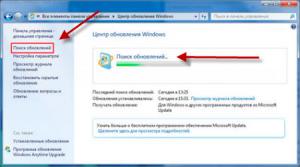
After installing Service Pack 1, you will see a window that says that windows does not need to be updated.


In the window that appears, select the entry for the key to upgrade the system;
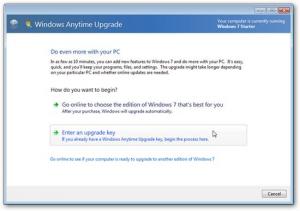
If your system interface is in Russian, then you need to select the next tab.
I will not tell you about that. where to get the keys to enter in the field that appears, since I am a supporter of licensed software, and I think that licensed products are the best solution for any application! But for those who still want to start the process of transition to more full version OS windows 7 without a license key, I can recommend a google search, which displays a bunch of links to a key generator for an upgrade already in the first ten expiration date.
Download the one you like best and generate a key for the version you need! I use license key from Microsoft to upgrade to Windows 7 Ultimate.
Then, following the instructions, a Windows update window will appear with an indicator of the progress of the task. When finished, the computer will automatically restart. It is necessary to repeat the above operations only when requesting an update key.
These manipulations will allow you to get Windows 7 Ultimate as your main OS. If you chose Professional as your version, I can assure you that you will not notice the difference visually and technically between Ultimate and Professional.
Why update OS Windows? A very large number of users believe that completing the installation operating system updates is an optional task that you can perform later. But this is not at all the case, since each OS update contains files that increase the level of stability and reliability of Windows.
Problems that are resolved with operating system updates
- Improving the stability and performance of the PC. Almost every package Windows updates contains new versions of drivers, thanks to which the power consumption of devices is reduced and their performance is increased. And new system modules and libraries make the work of the Windows operating system more rational and stable.
- System protection. All versions of Windows, even the most recent ones, have a large number of vulnerabilities, which cybercriminals use for their own purposes to obtain user data from your PC. Or in order to send spam, extract virtual currency, carry out DDoS attacks, etc. using your computer. In each package Microsoft updates closes loopholes, thereby protecting its users from criminal encroachments.
- Comprehensive hardware and software support. Manufacturers computer programs and equipment are constantly improving technologies by adding additional functions to their products. And if you do not install the appropriate system update, then Windows will not be able to use the new functions.
In the event that you do not have a stable Internet connection or there are traffic restrictions that do not allow you to download all updates, you should install at least those that have the "important" or "critical" status. Operating room update data Windows systems fix the most critical errors and eliminate the most dangerous vulnerabilities.
How do I update the Windows XP operating system?
Installation of updates in Windows XP is performed using the Windows Update Center from Microsoft, which can be accessed through the "Control Panel".
After entering Windows Update, you will be asked to choose one of three modes of downloading and installing updates, or to disable updates altogether. The best option Windows XP operating system updates is automatic scheduled updates.
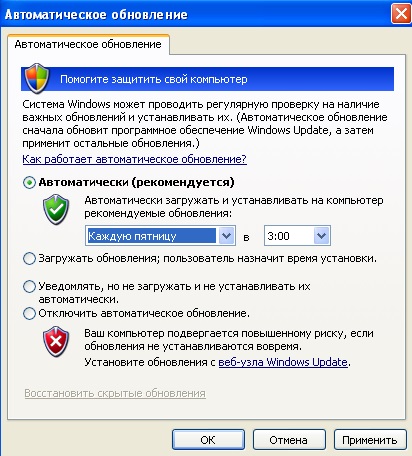
The main advantages of automatic Windows updates XP
Manual installation of updates requires certain user knowledge and time. Downloading and installing updates puts a load on the computer's resources, and this can lead to its freezing. If you configure auto-update of the system for a period of time when you are not using your PC, then such inconveniences will not arise.
- Windows XP service packs contain new system features and bug fixes. So, if you entrust the installation of updates directly to the operating system, you will not have to wonder which updates are needed for your PC and which are not. Windows XP itself will select the necessary updates and install.
- Your personal computer will always have high protection against all possible threats. Also, you will not need to periodically monitor the release of important and critical updates in order to install them on your PC. When vulnerabilities are identified, Microsoft releases patches that fix them. So, the sooner the OS receives such patches, the more secure your data will be.
To enable auto-update of the Windows XP operating system You should do the following:
- set the switch opposite the item "Automatically (recommended)";
- choose the time to download and install updates. It is recommended to choose a time when no one is working on your PC, for example, at night. For home personal computer it will be enough to perform updates once a week, but if there is very important information on it, then it is better to update the OS every day.
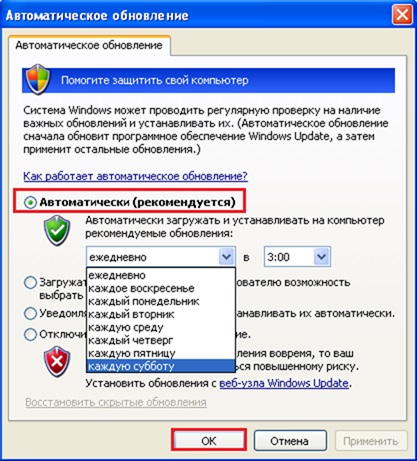
- click on the "OK" button.
The changes will take effect immediately and you will not have to worry about the security of your personal computer.
How to update the Windows 7 operating system
Search and installation of updates in the Windows 7 operating system is performed through the update center, which can be accessed through the "Control Panel" or using the wuapp.exe CMD command.
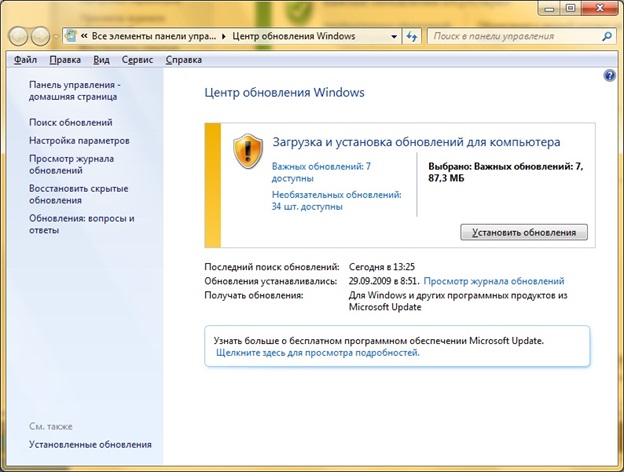
In order to check for updates and install them on Windows 7 OS, do the following:
- click on "Search for updates" in the left menu, then wait until the OS finds everything available updates;

- after the message about the need to install important updates appears, click on it. This will allow you to select the updates you want to install.
In the event that there are no important updates on your PC, or they have already been installed, then a window will appear in which you will be prompted to install optional updates.
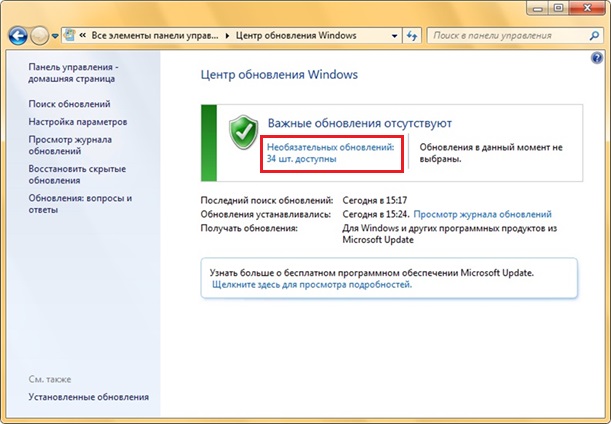
If you install in a timely manner important updates, it will significantly increase the security of not only Windows 7, but also the entire computer. Optional updates are basically driver or program updates that have little impact on the overall operating system.
How do I update the Windows 8 operating system?
Installing updates on the Windows 8 operating system is performed, as on Windows 7, using the update center. You can enter it through the wuapp.exe CMD command or through the "Control Panel".
In order to find updates, and then install them, you should follow these steps:
- in the Windows update center, click on the "Search for updates" item;

- after the OS finishes searching for updates, click on the "Install updates" button;
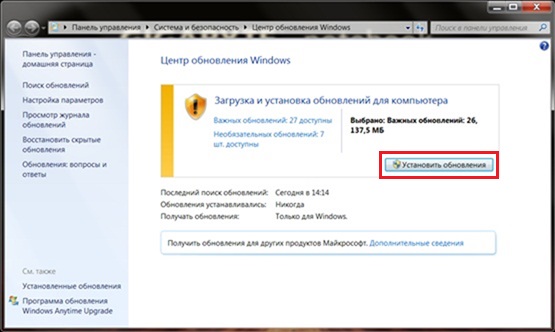
- now you need to wait a while while the Windows 8 operating system downloads and installs all updates. This window will inform you about it.
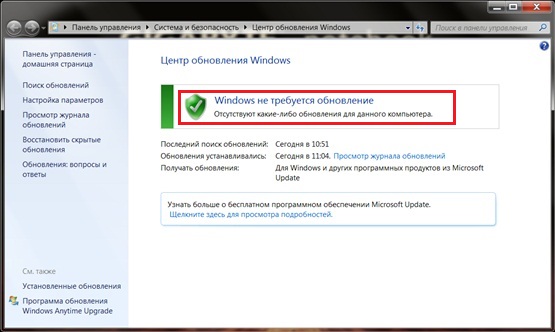
Remember that you should install updates, as they significantly increase the performance of your personal computer, as well as its protection.
If
your computer is running Windows 7
Starter or Home Basic, and you want
increase it to the Ultimate version for free, then there is
two ways.
How to update Windows 7

A window will open to view the basic information of the computer, we need its upper part.
Here you can see which one is installed Windows version but us in
currently wondering if the Service Pack is installed? Availability,
which is determined by the inscription Service Pack 1, if there is no such inscription,
go to the next step.

Installing the Windows 7 Service Pack
In the Start menu, in the search box, enter "Windows Update" and launch the found program.

A window like this will appear, click on the Install updates button.
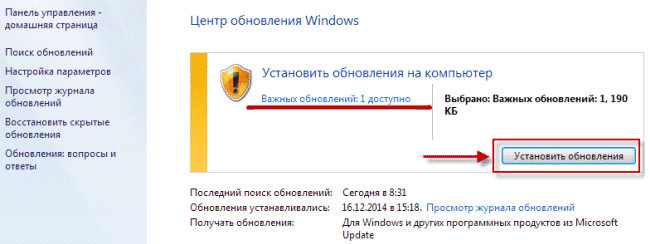
After installing the updates, the previous window with a yellow shield should change to such a window with a green shield.
If this did not happen, click on the tab on the left side of the Search window
updates ⇒ Install updates. We repeat this procedure until
a green shield will appear.

After successfully installing all updates, restart the computer, again
go to View basic computer information, now the inscription Service
Pack 1 should appear.
Transition Advisor
In order to determine whether it is possible to upgrade the computer to the Ultimatum version, download the transition advisor from this link.
You will be prompted to Download as an archive or an already unpacked file to
which appears the link only when you hover the mouse cursor to the right
corner of the yellow rectangle as seen in the screenshot.
I recommend the second option because it will be faster this way.
Now install the downloaded file.
![]()
Installation is complete, close this dialog box.

We just launch the created shortcut on the “Expert Advisor” desktop, in the window that opens, click the Start check button.
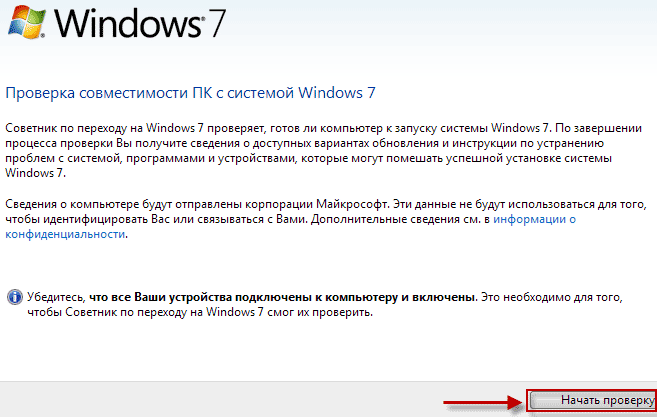
After checking the compatibility of the computer, an update window will appear.
Windows 7 upgrade process
Well, now we go to the main stage, for this we download the key generator, run it, in the window that appears, we see three versions of OC.
It should be updated on a first come, first served basis, i.e. if you have installed
Home Basic or Home premium then
first to professional and then advanced.

Opposite the version you need, press the "Generate" button, thereby generating an activation key.
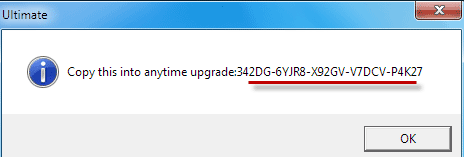
Without closing the window with the key, go to the Start Menu ⇒ All programs, we find "Windows Anytime Upgrade" and run.
Here you need to select: Enter the update key
After the update is complete, the computer will be restarted, and the system will be updated to the version you selected.
To check if the Activation has been completed, we repeat the steps described at the beginning
lesson steps to enter Computer Properties, at the bottom of the screen we are
we'll see.
Here on this one could congratulate you on successful activation, but if
you upgraded to Professional, then most likely you did it
three-day activation, in any case, I had it that way.
There is nothing wrong with that, you just need to upgrade to the Maximum version, in the above described way, that's all!
This concludes the lesson on how to update Windows 7, if you have any questions, I will always be happy to answer.
Valery Semenov, moikomputer.ru
| Categories: | |
Cited by
Liked: 2 users
Quite often, many users wonder how to update Windows 7 for free without incurring trouble. Today we will just discuss this topic. In addition, we will also figure out what pitfalls can be encountered and how to get around them.
Data security
The first thing to do before updating Windows 7 is to prepare properly. What do you need for this?
First of all, if you have already used your computer, it is best to prepare some kind of weighty drive, on which you can upload all your personal and important data a little later. The thing is that while working with operating systems, various failures occur, the consequence of which is, as a rule, a complete reinstallation. Nobody wants to lose their data. So it is better to play it safe once again before updating the version of "Windows 7" to a newer one.
It would be nice to stock up on a reinstallation disc with the operating system, just in case. This will help reduce your time and effort if a fatal error occurs in the course of work that can ruin the system. Nobody is immune from this. Now that you have the disk and all the data has been moved to a safe place, there are a few more things to know before starting the updates. What exactly?
Collecting information about your computer
There are a few more points that you need to know in order to answer how to update Windows 7. Its maximum version requires quite impressive computer resources... This means that your computer must comply with all system requirements, which is put forward by this or that "axis". 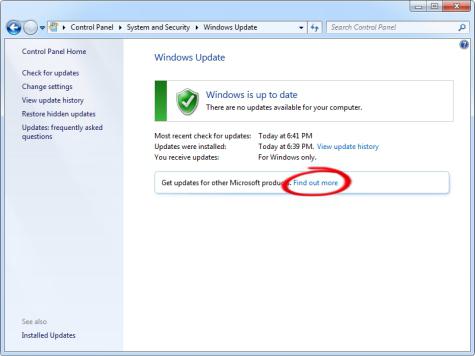
For this, your best bet is to look at the information on the Internet. And the information about the computer can be found in the "My Computer" section. Usually people are aware of what "systems" their computers have. So, if you are thinking how to update "Windows 7" (professional or any other), then compare how your computer meets your own ideas. If everything is in order here, then you can think about what to do next. There is very little left until the process itself.
Looking for updates
Now let's see how to update Windows 7. The initial preparation has already passed, it's time to think about where to get all the necessary update files. There are several options for the development of events. Let's look at both of them in order. 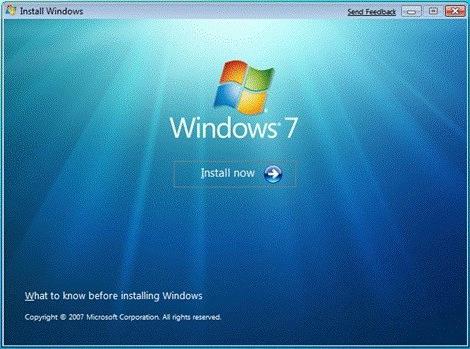
We'll start with the hardest way - looking for updates on the Internet. The search engine will help you with this. True, such manipulations can sometimes suffer a crushing fiasco, since under the guise of updates, various viruses and spyware can cover themselves that infect the operating system, after which they begin to destroy it. Not the most pleasant outcome.
So be careful when looking. It is best to use the official Microsoft website for these needs. All files on it have already been scanned for viruses. This way you can be confident in quality and reliability. Searching for updates on the Internet is one of the options for how to update Windows 7. But there is another, simpler method.
Automation
In Windows 7, Microsoft has been concerned about providing all possible updates to its operating systems while still allowing people to choose whether or not to install them. The so-called "Update Center" helps with this. Just he will help answer how to update Windows 7. 
With the help of this program, if you can call it such, each user has an excellent opportunity to see what updates are now available for his system, and then choose which ones to download and install. All this is done automatically, quickly and free of charge. However, not everyone uses this method.
If you decide to update the operating system using the update center, first check all available updates. To do this, there is a corresponding button in the service itself. You need the Internet to work.
When the process comes to an end, the operating system will tell you what updates and how many were found. This helps the user not to get confused and start downloading something that he does not need at all (for example, language pack Arabic). All that remains to be done is to mark the required update and download it. After that, it will already be possible to talk about the process of updating the operating system itself.
Caution won't hurt
But be careful. Before you update Windows 7, carefully watch what you download. As mentioned above, you can run into computer virus... The consequence of this can be a complete loss of all data and access to the system as a whole. There are such "worms" and "Trojans" that begin to send their owner your personal data that you enter.  It's about passwords and accounts. So, instead of the long-awaited update, you will lose all data, and even ruin your computer. Usually, this situation occurs when you search for updates yourself on the Internet. So it is highly recommended to use the Windows Update Center. But even here you need to be very careful.
It's about passwords and accounts. So, instead of the long-awaited update, you will lose all data, and even ruin your computer. Usually, this situation occurs when you search for updates yourself on the Internet. So it is highly recommended to use the Windows Update Center. But even here you need to be very careful.
The point is that you can stumble upon an update file that verifies the system for authenticity. And now, as you know, many people use hacked versions. So do not mark anything that starts with a "K" in the list of available updates. For example, K2065845. So, if you download a check update, you will get problems instead of the update. When you're completely ready, it's time to get busy with the reinstallation.
How to update
It doesn't matter which method you used. The main thing is that your update is already on the computer and is waiting for you to start the process. Run the update file. You will see a window that resembles a regular reinstallation. Read everything that is written in the window. Now click "Next". Eventually, after demonstrating your computer's compliance, the update process will begin. It will end automatically, after which the computer must be restarted. After that, everything will be over. You can rejoice at your success.
I'll start with the conclusions and then it will be detailed instructions with how I recommend updating the Windows 7 system, as well as about automatic update, about checking for updates manually, how to turn off updates and why you shouldn't turn them off. Go!
Updates must be installed. Good for that the way is suitable « Look for updates, but the decision to download and install is made by me».
And when you get messages from Windows Update that new updates have been found, you need to take the time to get busy downloading and installing Windows updates.
Periodically, you can manually check for Windows updates using the "Search for updates" option (number 1 in Fig. 1), without waiting for these updates to be detected automatically. And, if updates are found manually, install them on your PC as well.
With this approach, the Windows 7 operating system is up to date, and will be maximally protected from.
Let's now figure out how to configure updates and how to install them so that they remain useful, but not annoying. Windows users 7.
Where is the Windows 7 update program
This program is called Windows Update. It can be found
- through the Search line (the "Start" button - enter the text without quotation marks in the "Find programs and files" line: "Windows Update"),
- or through the "Control Panel" (button "Start" - "Control Panel" - "System and Security" - "Windows Update").
After that, a Windows Update window will open on the screen, as shown in Fig. 1:
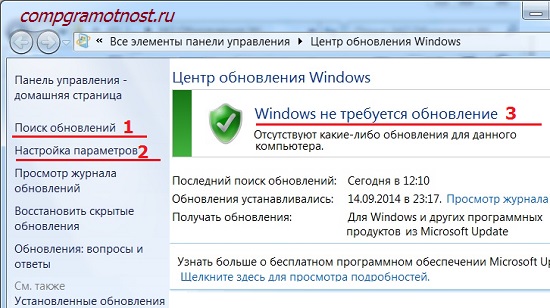
Rice. 1. Window of the program "Windows Update"
In this window, we will be interested in two options: "Search for updates" (number 1 in Fig. 1) and "Configure parameters" (number 2 in Fig. 1).
Configuring Windows 7 Updates
To configure updates, click on the "Parameter settings" label (number 2 in Fig. 1). A window for selecting a method for installing Windows updates will appear (Fig. 2):
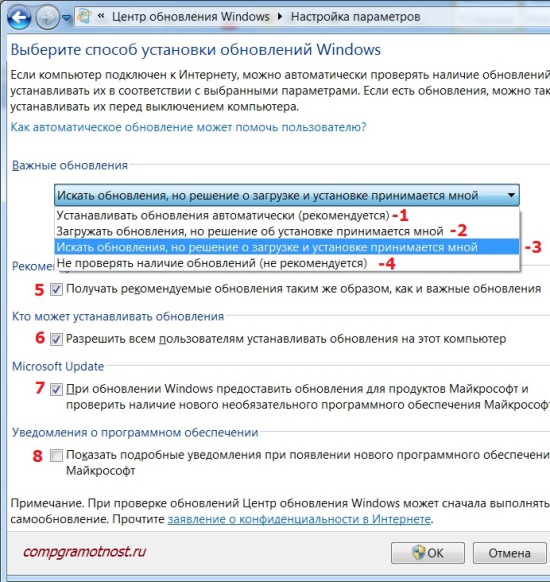
Rice. 2. Window for configuring updates for Windows 7
Screenshot in fig. 2 is made in the Windows 7 Professional operating system. For others, the update window may look different.
Windows 7 developers offer users of this operating system 4 ways to install updates (numbers 1 - 4 in Fig. 2).
If you are interested in the question "How to enable Windows 7 update?", You need to choose one of three methods:
- "Install updates automatically (recommended)" (number 1 in Fig. 2).
- "Download updates, but the decision about installation is made by me" (solid two, because in Fig. 2 - number 2).
- “Look for updates, but the decision to download and install is made by me” (number 3 in Fig. 2).
The question of how to "turn off Windows 7 update" is solved using the fourth method:
Let's consider all four methods in more detail.
I would also recommend this method if there were none. It lies in the fact that finding, downloading and installing Windows updates is a rather difficult and time-consuming task for a computer. This process does not go unnoticed by the user. During the search, download and installation of updates, the computer is heavily loaded, slows down the execution of other tasks and programs. And at the end of the installation of updates, it generally begins to require a system reboot.
And all this happens, as a rule, at the most inopportune moment. When there is no time to stop (pause) work and restart the PC.
For some reason, here I want to recall Murphy's law: "Left to themselves, events tend to develop from bad to worse." That is why I do not want to give the operating system the ability to independently search, download and install updates.
Let's look at the second method of installing Windows 7 updates.
Method 2 "Download updates, but the installation decision is made by me"
Realizing that the installation of updates requires additional loading of the PC and requires a reboot for the final installation of new programs, Windows developers offer us this, more simplified option than the previous one ("Install updates automatically").
Insofar as automatic search Updates and their download also requires PC resources, it also diverts the power of the computer to these processes.
And this makes it difficult for users, again at the most inopportune moment for this, as luck would have it. And here I would like to recall Murphy's laws: "When things are going well, something must happen in the very near future" and "When things go worse than ever, in the very near future they will go even worse."
Therefore, let's leave this way Windows updates alone, and move on to the third method.
Method 3 "Look for updates, but the decision to download and install is made by me" or How to disable automatic updates of Windows 7?
Here we see minimal diversion of computer resources. Namely, resources are diverted only to find updates for the Windows 7 operating system via the Internet.
Found updates will not be downloaded to the user's computer until the user decides to do so. This method is especially convenient for those who have Internet with limited traffic. For downloading updates is additional megabytes of downloadable from the Internet
Therefore, despite the fact that this is only the third on the list of ways to install Windows updates, but this is what I recommend for PC users.
We'll look at how to download and install updates later, but for now, let's move on to the fourth last method of installing Windows updates.
This is the last, 4th way to update the Windows 7 system.
And here I agree with the Windows developers that this method cannot be recommended for computer users.
For by applying this fourth method, the PC user thus refuses to receive and install any updates. And this can lead to an increase in security threats to the operating system, to an increase in its vulnerability.
In addition to choosing the method for downloading and installing Windows updates, in the window for selecting the method for installing Windows updates, set the following checkboxes (see Fig. 2):
- "Receive recommended updates in the same way as important updates"(number 5 in Fig. 2). Windows developers, in order to completely confuse PC users, came up with not only important (or in other words, mandatory) Windows updates, but also the so-called recommended updates. It is not possible to distinguish one from the other. Therefore, in order not to get confused, you must put a tick in front of this inscription.
- "Allow all users to install updates on this computer"(number 6 in Fig. 2). Why is this? If there are several accounts on the computer, under which different users can work, or even one user under different accounts, then this checkbox gives all of them the right to download and install updates. The checkbox is useful, because otherwise you can forget about updates for a long time if you work under account where updates will not be allowed. And this can lead to an increased threat of computer vulnerability.
- "When updating Windows, provide updates for Microsoft products ..."(number 7 in Fig. 2). It is also a useful checkbox, since it allows you to receive not only updates to Windows operating system files, but also to receive updates to application programs, such as, for example, Microsoft Office Word etc. These applications are also improved over time, and getting updates for them allows you to have the most up-to-date versions.
- Show detailed notifications when new software Microsoft "(number 8 in Fig. 2). You do not need to check this box, since this is a kind of consent to receive advertising information. You can put it, it won't get any worse.
So, we set the third method for installing Windows updates "Search for updates, but the decision to download and install is made by me." And set all of the above checkboxes (numbers 5-8 in Fig. 2).
Then we press the "OK" button (Fig. 2). The window for choosing how to install Windows updates will close.
Moving on to installing Windows 7 updates
Windows Update is now configured to constantly search for new updates. While there are no updates, in the Windows Update window there will be an inscription with a green background "Windows does not require updating", as shown by number 3 in Fig. 1.
But as soon as new updates appear and they are found, you will see the inscription "Download and install updates" with a yellow stripe (Fig. 6) indicating the volume to be downloaded from the Internet. This information is useful because for those with limited Internet traffic it allows them to decide whether to download updates.
Let's say if the traffic is limited to 50 Megabytes (for example, when using mobile internet), and you will have to download 100 megabytes of updates, then such information will be a warning that you do not need to do this.
Checking for Windows 7 updates manually
Updates can be checked manually without waiting for it to be done for us automatic program... To do this, in the "Windows Update" window, click on the inscription "Search for updates" (number 1 in Fig. 1). A "creeping" green line "Search for updates" will appear (number 1 in Fig. 3).

Rice. 3. Checking for updates manually using Windows Update
After a while, the search will end. The search result can be
- lack of updates,
- found optional (recommended) updates, or
- found mandatory (important) updates.
Both mandatory (important) and optional (but recommended) updates can also be found at the same time.
Installing Windows 7 updates
In fig. 4 below shows the Windows Update window after searching for updates when one optional (recommended) update is found.
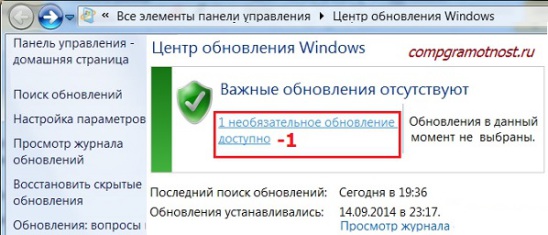
Rice. 4. Windows Update window after completing the search for updates, when one optional (recommended) update was found
In the window that opens, put a check mark (number 1 in Fig. 5) opposite the name of the update (in this case, this is an update for the program), and then click on the "OK" button (number 2 in Fig. 5):

Rice. 5. Preparing to install an optional update
After that, we will return to the Windows Update window (Fig. 6), where the “Download and install the selected updates” message will already appear, indicating the download size (in this case, it is a small amount, only 417 Kb). Here you should click on the "Install updates" button (number 1 in Fig. 6).

Rice. 6. Completing preparations for installing an optional update
After that, the installation of Windows updates will begin. The window (Fig. 7) will display the inscription "Updates are being installed ..." (number 1 in Fig. 7). And below it will show the installation progress. The installation of updates can be interrupted at any time by clicking on the "Stop installation" button (number 2 in Fig. 7).
But in general, it is not recommended to interrupt the installation of updates. It is better to wait until the installation is complete, although in some cases it may take a long time.
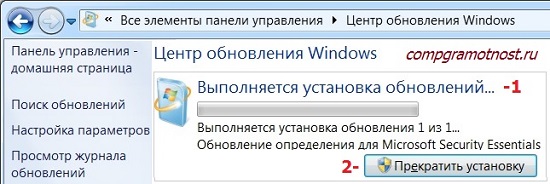
Rice. 7. Performing the Windows update installation procedure
At the end of the installation, the message "Updates installed successfully" may appear, as shown in Fig. 8. But if there are a lot of updates, and they are complex, then you may need to restart the operating system. In this case, the Windows Update window will prompt you to restart. It is advisable to agree with this and reboot the operating system in order to finally complete the installation of updates.
Rice. 8. Windows updates installation completion window
During the restart of the Windows 7 operating system after the installation of Windows updates, you must not turn off the computer until the complete cycle of unloading (shutting down) the system and then loading the system. This can also take a decent amount of time, but you need to be patient and complete this process in a regular way, without interrupting it halfway.
Also during reboot on blue screen You may receive messages about the progress of installing Windows updates. The percentage of installation completed will be shown.
As a rule, when the system is unloaded, the updates are installed at 30%, after which the computer turns off for a moment and starts rebooting. During download, the updates are already installed at 100%, which can also be displayed on a blue screen.
Still, why do we need updates?
Not so long ago, it stopped updating. Support and development of this version of the operating system has been discontinued. And somehow it immediately became a little sorry to part with the familiar system.
Until the end Windows support XP, many PC users resented the frequent updates that automatic mode came to computers. Now they are gone, and it turns out that you can even "miss" them.
It turns out that as long as the operating system is supported by the developers, while updates to the operating system come one after another, it is a workable "live" system. No updates - no system life. There are updates - there is support and development of the operating system.
Operating system updates are designed to continually improve its performance and improve the security of its operation. Without updates, the operating system may become vulnerable, some programs or some technical devices may stop working in it.
P.P.S. To subscribe to receive new articles which are not yet on the blog:
1) Enter your e-mail address in this form.
 Bugs in Singularity?
Bugs in Singularity? Just Cause 2 crashes
Just Cause 2 crashes Terraria won't start, what should I do?
Terraria won't start, what should I do?